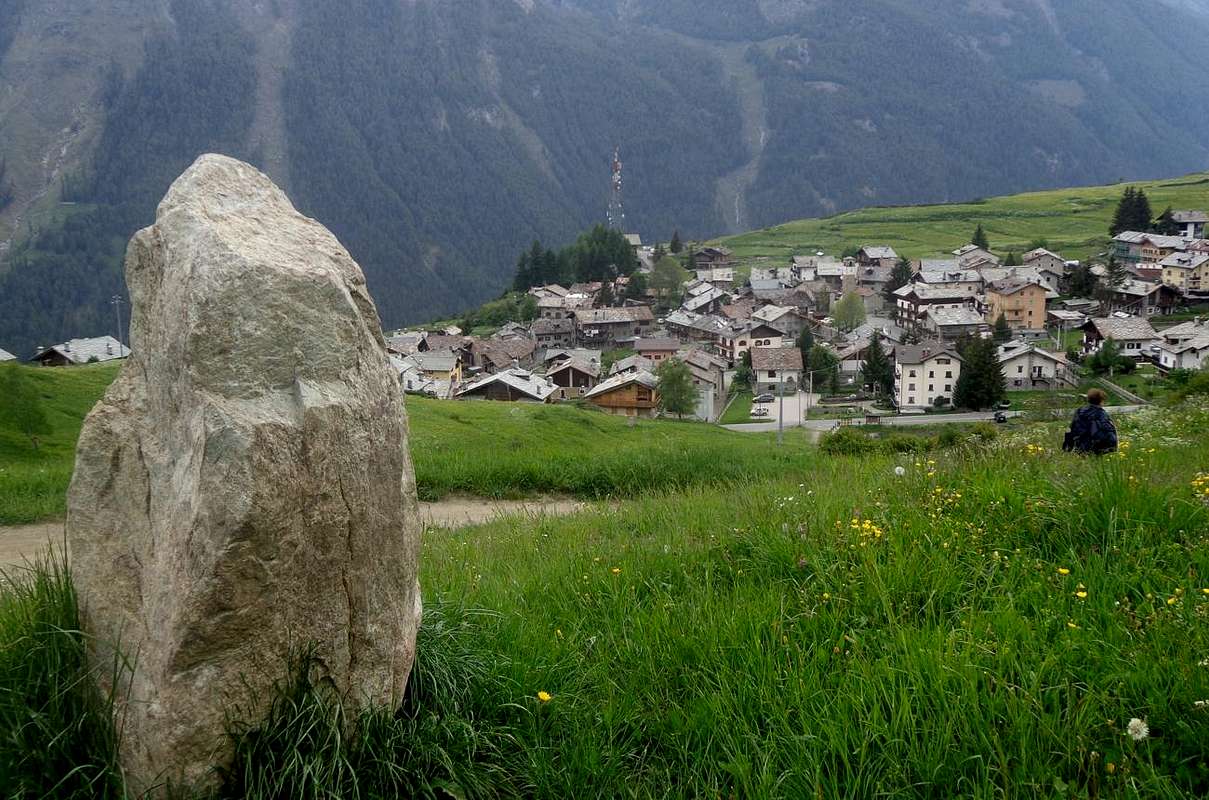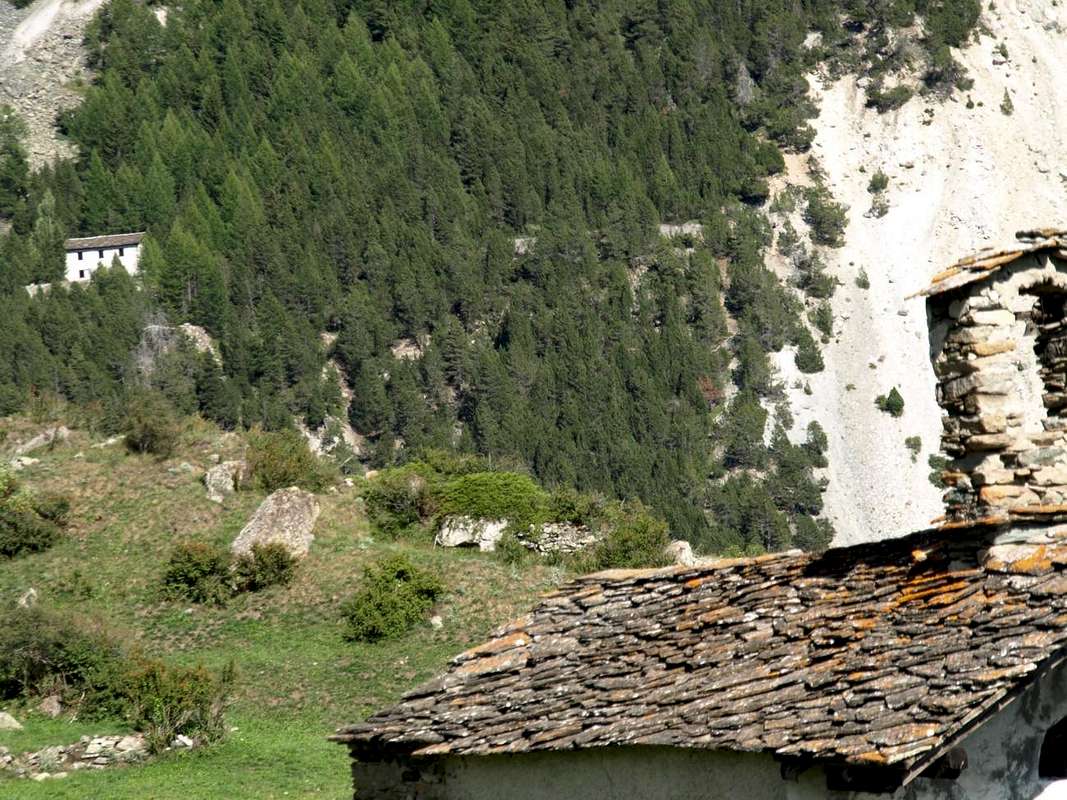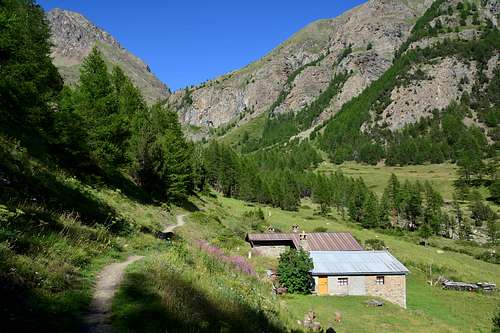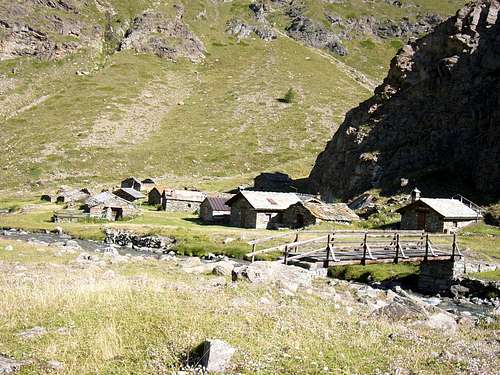-
 1554 Hits
1554 Hits
-
 83.69% Score
83.69% Score
-
 17 Votes
17 Votes
|
|
Area/Range |
|---|---|
|
|
45.64920°N / 7.38177°E |
|
|
Hiking, Mountaineering, Scrambling, Canyoneering |
|
|
Summer, Fall |
|
|
11355 ft / 3461 m |
|
|
Note
La montagna chiama i suoi figli, ed essi rispondono fedelmente al suo appello… Osvaldo Cardellina, Diario alpinistico, 1964-65 Page texts: @ OsvaldoCardellina "Osva", passed away on May 2, 2022. Page owners: Christian Cardellina e Osvaldo Cardellina. Any updates from September 12, 2022: Antonio Giani, page administrator, friend and climbing companion. Testi della pagina: @ OsvaldoCardellina "Osva", scomparso il 2 maggio 2022. Proprietari pagina: Christian Cardellina e Osvaldo Cardellina. Eventuali aggiornamenti dal 12 settembre 2022: Antonio Giani, amministratore della pagina, amico e compagno di salite. |
Overview
a) - Valle di Cogne Map of the paths 10 , on a scale of 1:25.000 with UTM coordinates by "L'ESCURSIONISTA editore" Rimini 2007 and
b) - Conca di Aosta Map of paths 4, on a scale of 1:25.000 with coordinates U.T.M. by "L'ESCURSIONISTA editore", Rimini 2008; moreover further measurements (more "skinny" and with minimal differences) in Carta Hapax - Aosta 2008, always on a scale of 1:25000 by the "Comunità Montana Mont - Emilius Cartografia Hiking ", 2nd edition, Aosta 2008. Generally, about almost all the Summits, however in summitpo su SP. in the first mentioned were taken into account, in order not to incur various inconsistencies. In other cases, where certain or completely non-existent measurements do not yet exist, an assessment was made based on personal experience by adding, second the opportunities, the preposition or adverb entry "circa" (about, around).
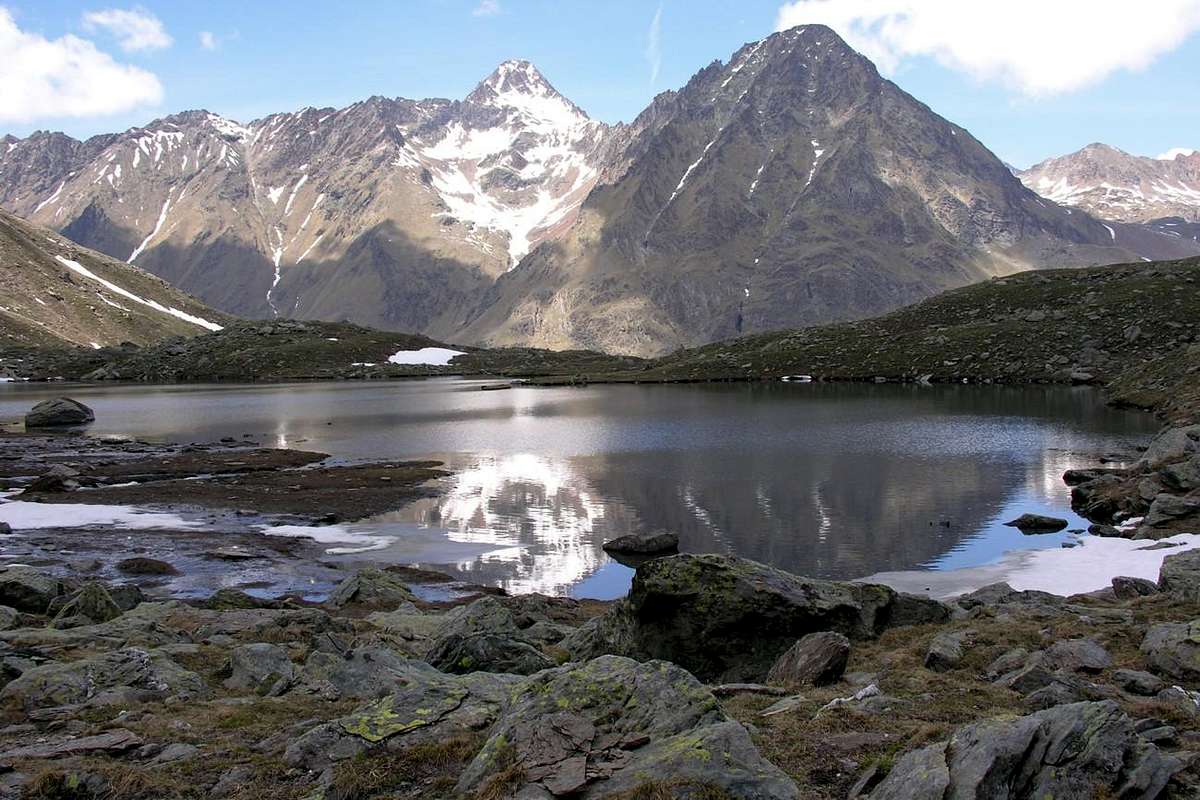
Historically speaking ...
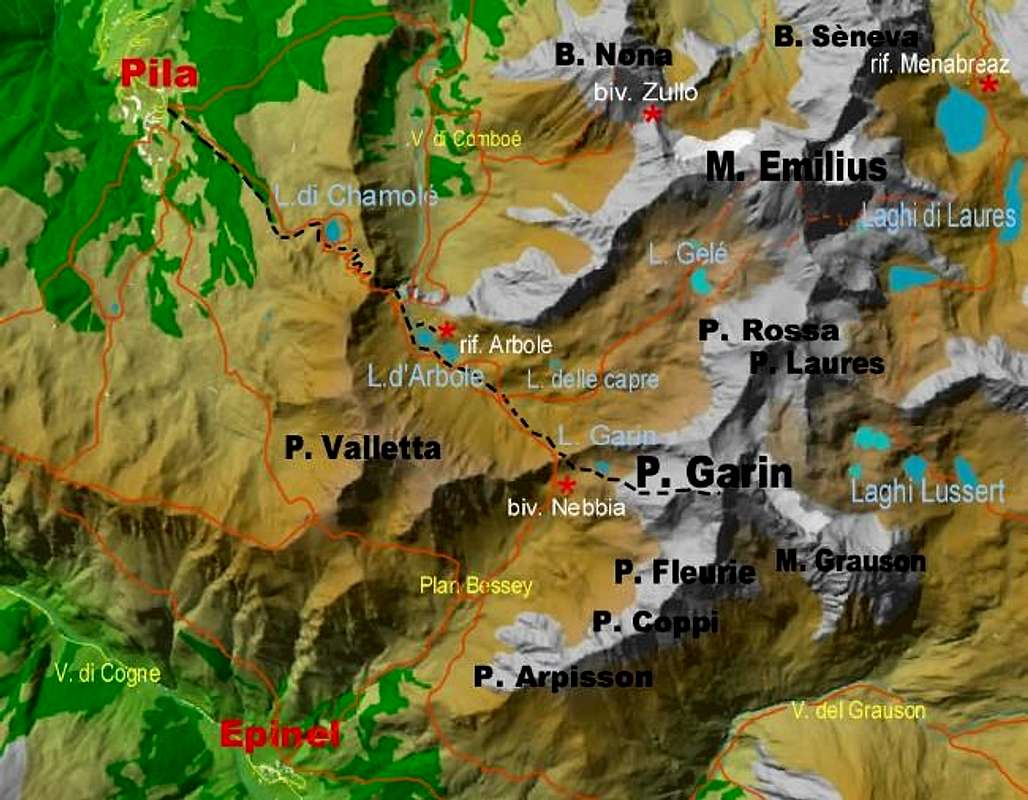
Coming in greater detail, we must identify this small wild and absolutely ice-free basin, in a valley located at the base of the Eastern slope of the Punta or Peak Garin, of which the origin of the toponym escapes (probably it marked the limits of an old pasture) which absolutely has nothing to do with the cyclist Maurice Garin, originally from Arvier in Aosta Valley and winner of the first Tour de France registered in 1903 (of cycling names we already see enough of them as for the nearby Pointes Coupèes or Coupì d'Arpisson which have become for the IGM Punte Coppi and as such taken from all the cartography in existence; while instead the herdsman of the time questioned by the topographer had simply replied : Pointes Couppì, or "Cut Tips", being that all three appear as truncated cleanly by a razor. Besides, at the time the famous cyclist Fausto Coppi was still not born ...). While the toponym Chaz and also Crot refers to the term alp, pasture or pasture the highest and probably the oldest known. Certainly also abandoned, since no trace of it remains, as for the relative "sentierucolo" (little path) which, lost in time, has experienced a certain "rebirth" in recent times, especially thanks to the wooden walkway built on the Torrent de Lussert, immediately behind of the Alpe di Grauson Vieux or Desòt (Vecchio or di Sotto, 2.271/3 meters). Where cows grazed, over time it has become a steep terrain suitable for goats. But it was not so once, when the same had had a certain attendance so that:... "... Chaz Fleurie, three quarters of an hour, tradition places a gold mine there. Pic Garin, summit; two and a half hours. In all four and a half hours." As told by the first climbers of the pyramid from the Cogne side, that is, by the party of the famous Abbé Gorret (one of the protagonists of the first ascent to the Matterhorn in 1865) which reports in an article in the Bulletin "CAI 1866 , n. 7, where on page 48 it tells with detail of the "Ascension de la Pointe Garin sur Cogne ... Enfin, le 23 aout 1866, je pars deCogne accompé de M. le recteur Carrel, de trois élèves de Cogne et d'un jeune homme d'Aosta. Nous nous proposons bien de laisser le jeune Laurent au chalet de Grauson, mais il voulout nous suivre et il y reussit. Nous partons a six heures, à huit et un quart nous étions a Grauson. De là nous montons herborisant, jusque au creux de Chaz Fleurie; puis par les pierres et les clapeys (great broken boulders), nous arrivons à midi au sommet du pic ... ". And this also explains that "Crot", synonymous with "Creux", which means a hole, a hole, or a poor shelter, almost a cave as it must have been where the poor shepherds they had found each other a place and space for night rest . Before going back to the chalets of Grauson Vieux which, by comparison, seemed to be a royal palace. Again the Gorret in "Guide de la Vallée d'Aoste 1977": " ... on suit la route précédentejousu'à Grauson (vedi Col du Coronas ou Pas de St. Marcel) d'ou l'on prend à gauche en contournant la Tour Grauson pour se rendre à Chaz Fleurie, de où l'on monte en ligne droite par des clapeys et des rochers faciles jusq'à la sommité d'où l'on jouit d'un magnifique panorama ...". Further confirmation of this also occurs from the famous mountain guide book "Guide of the Western Alps vol. II, part II", published by the CAI Section of Turin 1896 and 1889; which as regards the Via Normale at Punta Garin starting from Cogne reads: "... followed the itinerary of the Colle Coronas up to the Grauson farmhouses. Then crossed the stream you take a path that heading west climbs along the southern slopes of the Tour Grauson, and then, turning north, leads into a dingy little valley, occupied by a maceret of shards of sharp rock, called Chaz Fleurie. summit. 3 hours from the farmhouses. ". Thus from the middle to the end of the 19th century the ascent to the pyramid was "framed" starting from the town of Cogne.
^^^^^^
^^^^^^
Venendo a maggior dettaglio, si deve individuare questo piccolo bacino selvaggio ed assolutamente privo di ghiacci, in un valloncello posto alla base del Versante Orientale della Punta o Picco Garin, della quale sfugge l'origine del toponimo (probabilmente segnava i limiti di un pascolo) che non centra assolutamente con il ciclista Maurice Garin, originario di Arvier in Valle d'Aosta nonché vincitore del primo Tour de France targato 1903 (di denominazioni ciclistiche già ne vediamo abbastanza come per le vicine Pointes Coupèes o Coupì d'Arpisson che sono diventate in IGM Punte Coppi e come tali riprese da tutta la cartografia in esistenza; mentre invece il mandriano dell'epoca interrogato dal topografo aveva semplicemente risposto: Pointes Couppì, ovvero "Punte Tagliate", essendo che appaiono tutte e tre come troncate di netto da un rasoio. Tralaltro all'epoca il famoso ciclista Fausto Coppi ancora non era nato ...). Mentre il toponimo Chaz ed anche Crot si riferisce al termine di alpe, alpeggio ovvero di pascolo il più elevato e probabilmente il più antico conosciuto. Di certo anche abbandonato, poiché non ne rimane traccia alcuna, come per i relativo sentierucolo che, andato disperso nel tempo, ha conosciuto una certa "rinascita" negli ultimi tempi, soprattutto grazie alla passerella in legno costruita sul Torrent de lussert, subito alle spalle dell'Alpe di Grauson Vieux o Desòt (Vecchio o di Sotto, 2.271/3 metri). Là dove pascolavano le mucche, nel tempo é diventato un erto terreno adatto alle capre. Ma non era così una volta, allorché il medesimo aveva avuto una certa frequentazione tanto che: ... "... Chaz Fleurie, trois quarts d'heure, la tradition y place une mine d'or. Pic Garin, sommet; deux heures et demi.En tout quatre heures et demi.". Come da racconto effettuato dai primi salitori della piramide dal versante di Cogne, cioé dalla comitiva del famoso Abbé Gorret (uno dei protagonisti della prima ascensione al Cervino nel 1865) che ne relazione in un articolo del Bollettino" CAI 1866, n. 7, dove in pagina 48 racconta con dovizia di particolari de l'"Ascension de la Pointe Garin sur Cogne ... Enfin, le 23 aout 1866, je pars de Cogne accompagné de M. le recteur Carrel, de trois élèves de Cogne et d'un jeune homme d'Aosta. Nous nous proposons bien de laisser le jeune Laurent au chalet de Grauson, mais il voulout nous suivre et il y reussit. Nous partons a six heures, à huit et un quart nous étions a Grauson. De là nous montons herborisant, jusque au creux de Chaz Fleurie; puis par les pierres et les clapeys, nous arrivons à midi au sommet du pic ...". E ciò spiega anche quel "Crot", sinonimo di "Creux", che sta a significare di un buco, un pertugio, ovvero un ricovero misero, quasi una caverna come doveva essere quello dove i poveri pastori trovavano addiaccio e spazio per il riposo notturno. Prima di ridiscendere ai chalets di Grauson Vieux che, al confronto, parevano essere una reggia. Ancora il Gorret in "Guide de la Vallée d'Aoste 1977": " ... on suit la route précédentejousu'à Grauson (vedi Col du Coronas ou Pas de St. Marcel) d'ou l'on prend à gauche en contournant la Tour Grauson pour se rendre à Chaz Fleurie, de où l'on monte en ligne droite par des clapeys et des rochers faciles jusq'à la sommité d'où l'on jouit d'un magnifique panorama ...". L'ulteriore conferma acciò avviene anche dalla famosa guida di montagna "Guida delle Alpi Occidentali vol. II, parte II", edita dalla Sezione del CAI di Torino 1896 e 1889; la quale per quanto concerne la Via Normale alla Punta Garin partendo da Cogne recita: " ... seguesi l'itinerario del Colle Coronas fino ai casolari Grauson. Poi attraversato il torrente si prende un sentiero che dirigendosi verso ovest sale lungo le propaggini meridionali della Tour Grauson, e quindi, volgendo verso nord, conduce in uno squallido valloncello, occupato da un macereto di frantumi taglienti di roccia, chiamato Chaz Fleurie. Lo si risale fino alla sommità dove si afferrano le roccie della piramide che con un agevole scatata portano alla vetta. Ore 3 dai casolari.". Così dalla metà alla fine dell'800 era "inquadrata" la salita alla piramide con partenza dall'abitato di Cogne. E, passando per il Villaggio di Montroz (1.702 m), la Frazione di Gimillan (1.787 m), il Villaggetto del Tarabouc (1.831 m), oppure con un sentierucolo ancora più in basso e tutt'oggi esistente che si riuniva al precedente nei pressi della Croce e poi dell'Alpe diroccata del Rèvènti (1.895, 1.906 metri), per poi "scollinare" all'Ecloseur (1.903 m) transitando sull'omonimo ponte in legno e pietra al di sopra del Torrent Gru (contrazione di Groson o Grauson); quindi all'Alpe Pila con la sua impetuosa cascata (2.003, 2.021 metri), alla quale perviene un orrido canalone che, scendendo dalle Pointes Coupées d'Arpisson, taglia in due le Cote Lavà o Lavaz. Oltre, il sentiero N° 8, doppiato un promontorio roccioso con bella vista dall'alto sulla cascata (2.156 m), si distende a Nordest fronteggiando dall'alto di un centinaio di metri la parte basale del Vallone di Crot Fleurie, che da questo tratto risale al di là del torrente in piena vista verso nord-nordovest. Ma non ci si può ancora indirizzare verso il Vallone della Chaz Fleurie, perché vi è una discesa ripida che conduce ad un guado molto pericoloso, oltre il quale si erge una fascia di rocce ripide solcate da una mezza dozzina di torrentelli. Conviene continuare in quasi rettilinea salita verso l'Alpe di Creuzet (2.244 m) che si lascia appena dabbasso per raggiungere un'evidente Croce (2.294 m) allo imbocco del pianoro di Grauson Vieux (2.271/3 m). Lasciato sulla destra il sentiero che prosegue verso i Valloni di Lussert, Tsesère, Corona e Tessonet/Doreire, si passa sopra un ponticello in legno, appena al di sopra dell'unificazione dei Torrents de Corona e de Grauson, che in breve conduce al medesimo.

Getting There
BY CAR:
- From TORINO, MILANO, etc: Motorway A5. Exit at IVREA or Quincinetto (PIEDMONT) AOSTA West/Aymavilles, Cogne Municipalities.From Aymavilles (646m) towards Cogne Valley: Vieyes (1.132m), Gontier private Shelter, through path in Nomenon Vallon. To Cogne (1.534m); through Main Road. To Valnontey (1.678m); Money, Alessandro Martinotti, Stefano Borghi, Pol, Gerard-Grappein, Lionello e Lucio Leonessa, Mario Balzola, Damiano Gratton. (This last from Epinel (1.436m) (1.494m) or Crétaz Fractions) Bivouacs, through paths, moraines and glacier, & Sella Refuge, through muletrack). From Lillaz Fraction (1.607m) to Sogno di Berdzé, under the Fenêtre of Champorcher, and Antoldi-Malvezzi Refuges, by dirt road, muletrack or paths in Urtier and Valeille Vallon. To Gimillan Village (1.785m), Nebbia Bivouac, with path in Arpisson Vallon. All the three last through Regional Roads from Cogne.
- From FRANCE: through the Mont Blanc Tunnel to Entrèves-crossroads to Vény/Ferret Valleys - Mountain Guides of Courmayeur - La Saxe Rock Gym - Courmayeur. By Little Saint Bernard Hill, closed since November until half May to La Thuile Valley - Pré Saint Didier - Courmayeur. It is not necessary to take Motorway A5: you can drive on SS.26, in the direction of AOSTA - IVREA - TURIN.
BY PLANE:
- Aeroporto "Corrado Gex" Saint Christophe (Aosta).
How to go and what routeways you can do

Campings
Remember that free camping is forbidden (except for emergency reasons, over 2.500m, from darkness until dawn).Mountain Condition
- Meteo: you can find all the needed informations at the official site of the Valle d'Aosta Region:
- Valle d'Aosta Meteo
Webcam
- WEBCAM on Aosta Valley:
- Webcam
Books and Maps
BOOKS:- "Guida delle Alpi Occidentali" di Giovanni Bobba e Luigi Vaccarone C.A.I. Sezione di Torino Volume II (parte II), 25 Maggio 1896.
- "Guida del Monte Emilius" di Osvaldo Cardellina Editore in collaborazione con il Club Alpino Italiano Sezione di Aosta, Dicembre 1978 (in Italian).
- "Guida dei Monti d'Italia Emilius Rosa dei Banchi Parco del Mont Avic" di Giulio Berutto e Lino Fornelli - Club Alpino Italiano/Touring Club Italiano, Marzo 2005.
- "Gran Paradiso", G. Klotz, Ed. Bergverlag GmbH Rother, Monaco 2005 (in tedesco)."
MAPS:
- Kompass "Gran Paradiso Valle d'Aosta Sentieri e Rifugi" Carta Turistica 1:50.000.
- Hapax "Les Sentiers Comunità Montana Monte Emilius", Luglio 2000 1:25.000.
- Enrico Editore Ivrea-Aosta "Gruppo del Gran Paradiso" 1:50.000.
- I.G.C. Torino "Carta delle Passeggiate ed Escursioni in V.D.A. Conca di Pila-Gressan" 1:20.000.
- L'Escursionista "Valle di Cogne Carta dei Sentieri" (n° 10) 1:25.000.
- L'Escursionista "Tour de la Vallée de Cogne Grand Paradis" Carta dei sentieri 1:25.000.
Important Information
- REGIONE AUTONOMA VALLE D'AOSTA the official site.
- FONDAZIONE MONTAGNA SICURA Villa Cameron, località Villard de la Palud n° 1 Courmayeur (AO) Tel: 39 0165 897602 - Fax: 39 0165 897647.
- SOCIETA' GUIDE ALPINE DI COGNE Tel. 347/9473526 – 328/1373728.
- A.I.NE.VA. (Associazione Interregionale Neve e Valanghe).
- A.IA.T. Cogne Gran Paradis via Bourgeois n° 34 Tel. 0165-74040. E-mail: aiat@cogne.org
- Ezio Sport articoli sportivi - via Bourgeois n° 64 Tel. 0165-74204.










